Tags :: Adventure
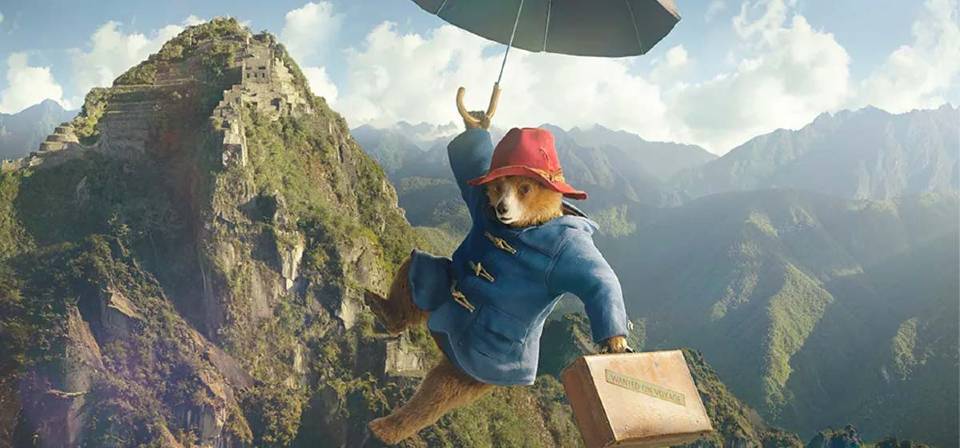
Paddington in Peru is pleasant, underachieving nonsense
The decency and goofy sweetness of the King films continue in Paddington in Peru, though the broader moral and social themes are lost in the quest adventure plot.
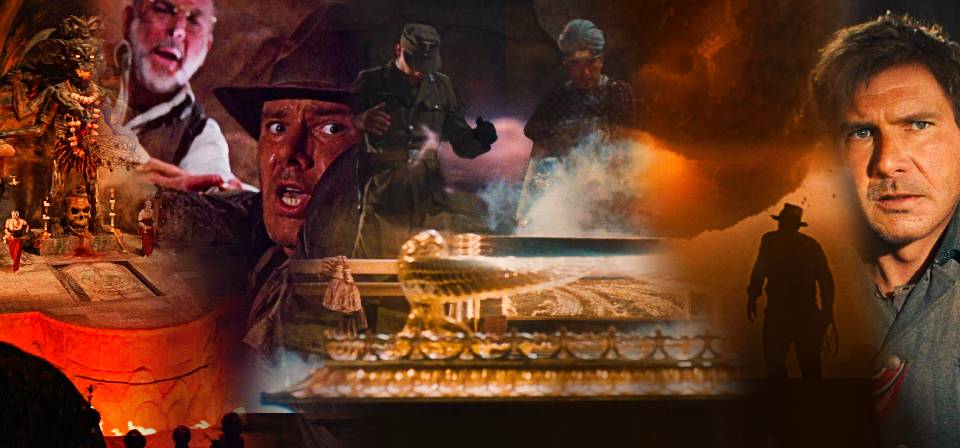
Indiana Jones movies and Raiders of the Lost Ark: Why the original still stands alone
Eight years earlier, The Exorcist offered a gut-wrenching morality tale about, among other things, the spiritual dangers of messing around with Ouija boards and demons. The climax of Raiders offers a complementary warning about trifling with the no less terrible power of the holy.
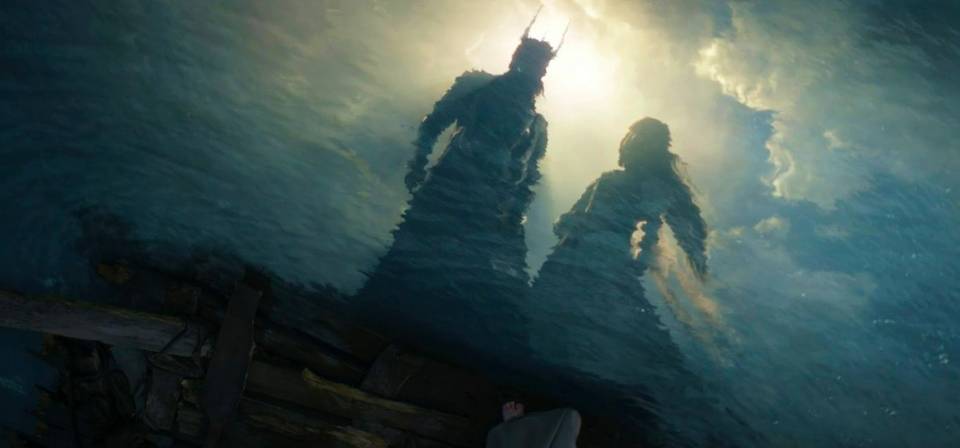
The Rings of Power at the end of season 1
Season 1 ended for me closer to the quiet end of the whimper-bang spectrum than I had hoped. Yet the highs of the season’s second half offer ongoing reason for sustained interest.
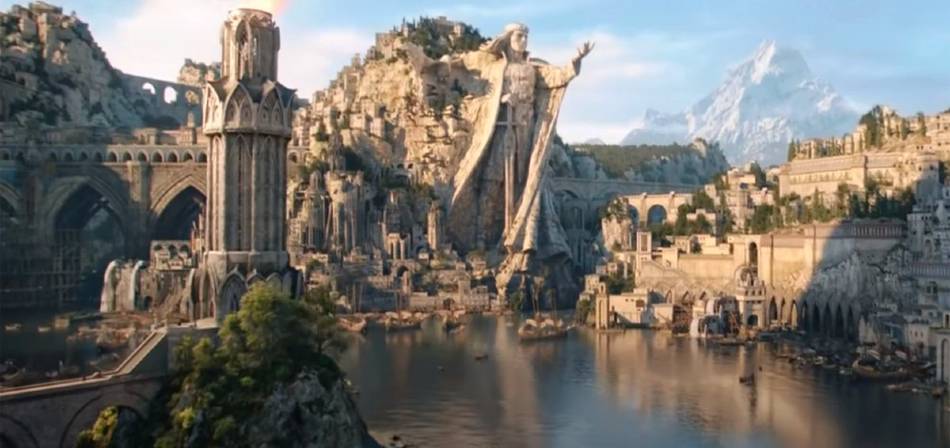
The Rings of Power: Season 1 at the halfway mark
Four episodes in, the lavish Amazon Prime series is delivering on at least some of its promise, but there’s room for improvement.
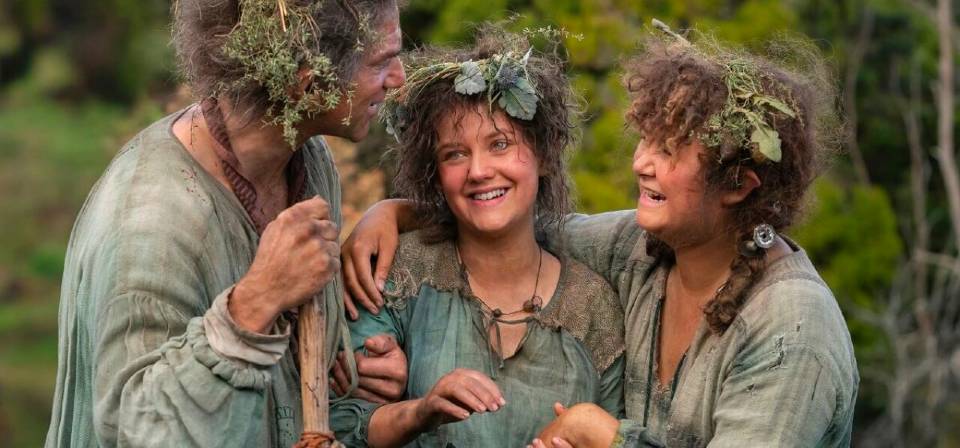
A new foray into Middle-Earth: The Rings of Power
A Game of Thrones–ification of Tolkien? More Hobbit trilogy excess? Though not without missteps, Amazon’s ambitious Lord of the Rings prequel series gets off to a fairly promising start.
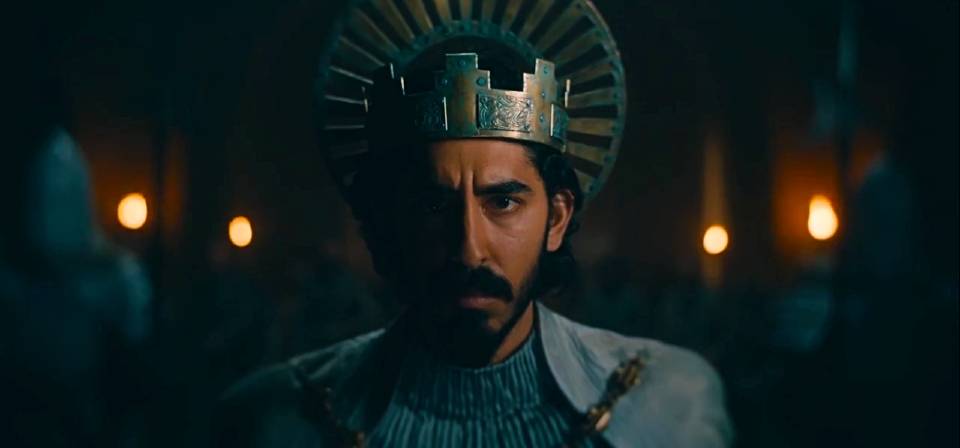
A deep cut: The Green Knight
After the library of books that is the Bible, no literary corpus means more to me than Arthuriana, and no Arthurian work means more to me than Sir Gawain and the Green Knight.
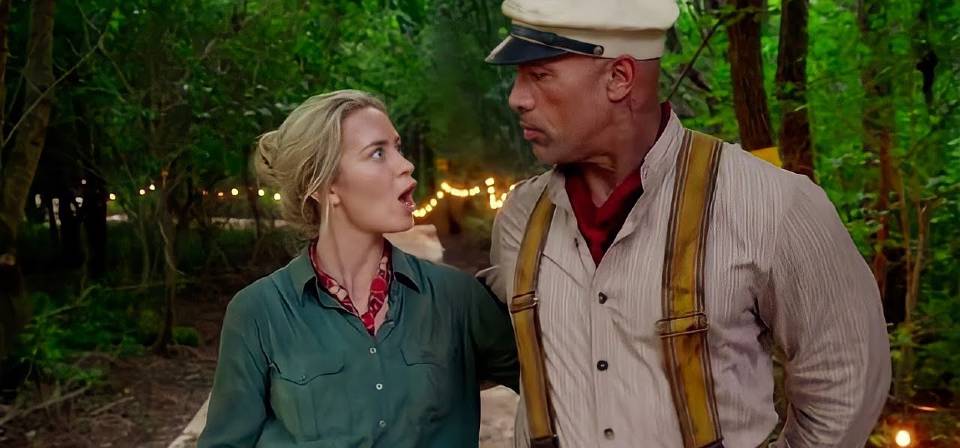
Jungle Cruise (2021)
Dwayne Johnson and Emily Blunt are highly watchable, but Disney’s latest theme-park movie trails haplessly in the wake of Pirates of the Caribbean without a ghost of its inspiration.
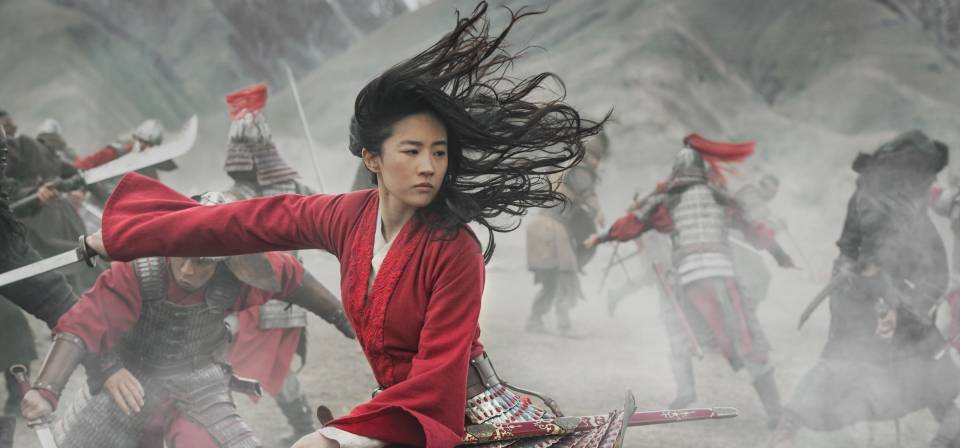
Mulan (2020)
At this point it seems pretty clear that the kiss of death, creatively speaking, for Disney’s new line of live-action/CGI remakes is a Broadway musical.
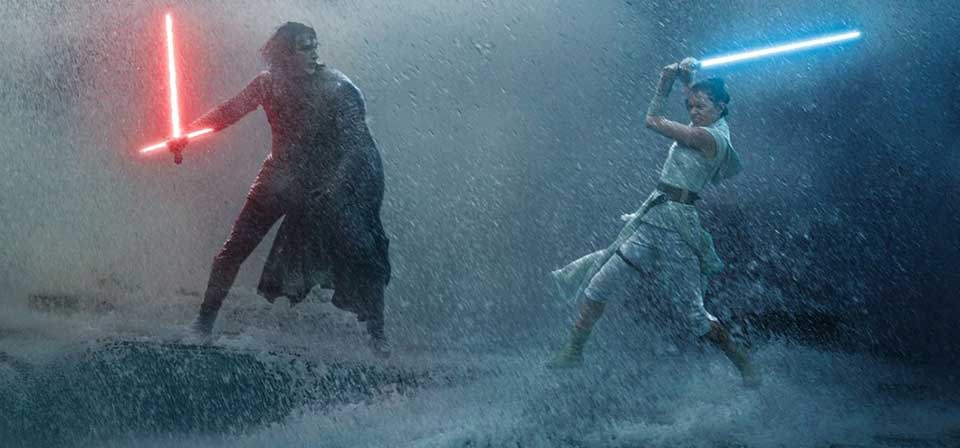
Star Wars: Episode IX – The Rise of Skywalker (2019)
Let’s face it, they could play John Williams’ ominous “Imperial March” over scenes of Uncle Deadly from the Muppets lobbing Green Goblin pumpkin-bombs at Scrat the saber-squirrel (I mean, they literally could, legally, and you could watch it on Disney+ forever and ever), and many of us would still feel emotions stir.
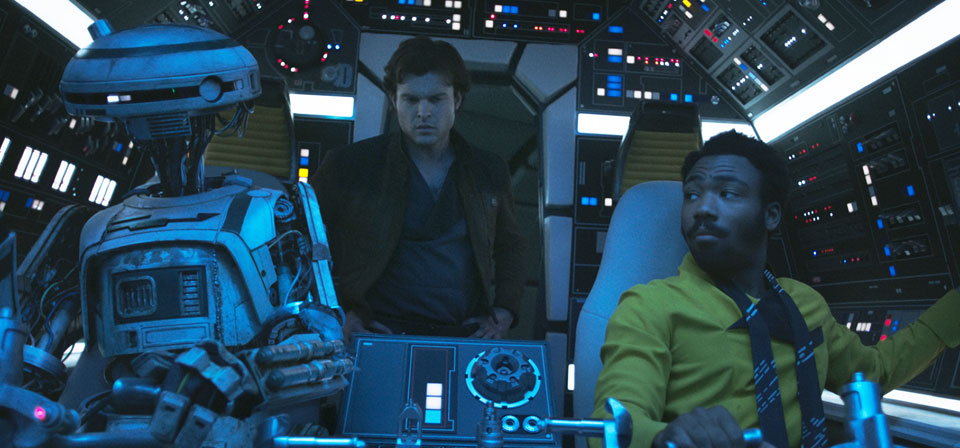
Solo: A Star Wars Story (2018)
Watching Disney’s Rogue One and Solo, the two stand-alone “Star Wars Story” movies that come without episode numbers and opening crawls, is a little like watching the legendary Dutch boy trying to plug the leaks in the dike with his fingers … as new leaks burst all around him.
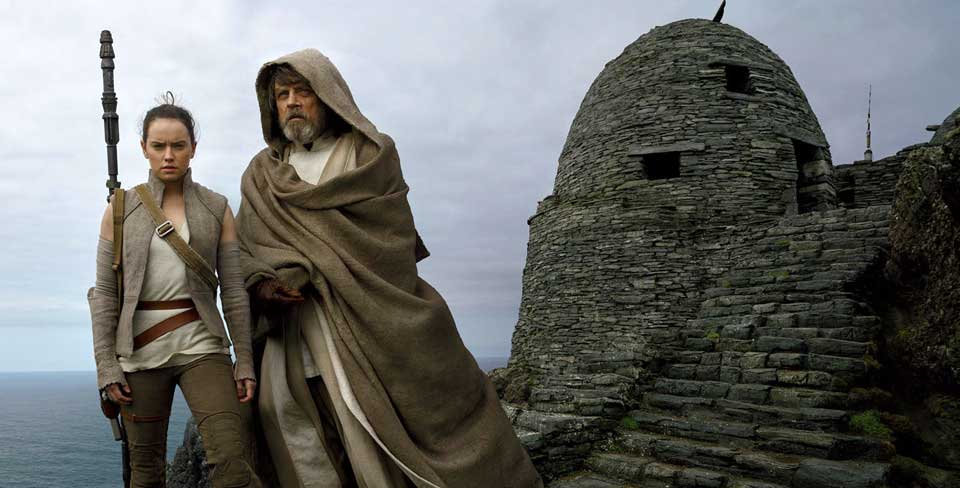
Star Wars: Episode VIII: The Last Jedi (2017)
Star Wars: Episode VIII — The Last Jedi is a strange beast: a swashbuckling action movie that is deeply skeptical of derring-do; a middle movie that works better as riff and commentary on the original source material than as a sequel to its immediate predecessor.
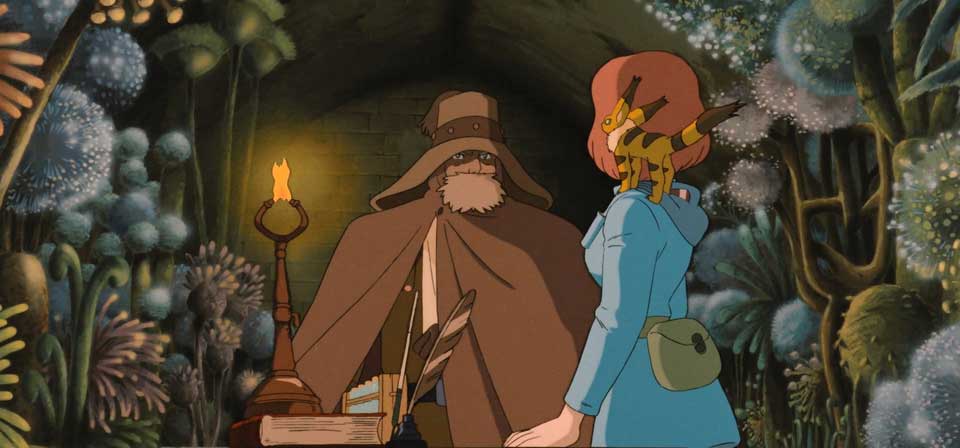
Nausicaä of the Valley of the Wind (1984)
(Reviewed by Sarah E. Greydanus) Nausicaä of the Valley of the Wind may be the quintessential Hayao Miyazaki film — not necessarily his best, but the most comprehensive assortment of his characteristic themes and motifs.
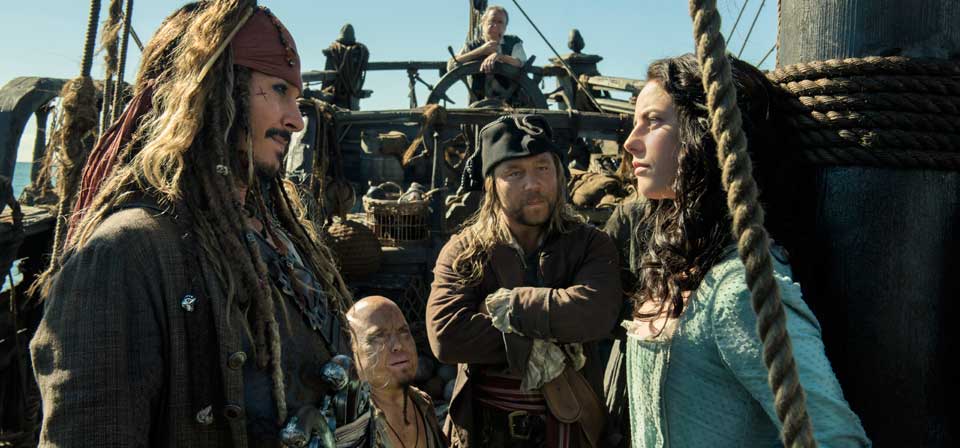
Pirates of the Caribbean: Dead Men Tell No Tales (2017)
Even skeptics of the franchise must admit, I think, that the Pirates of the Caribbean films have generally aimed higher and been smarter than might have been expected.

The Jungle Book (2016)
Like Kenneth Branagh’s Cinderella last year, The Jungle Book offers a lavish new reimagining of a beloved story, blending elements from the original literary source material with the classic animated Disney version.
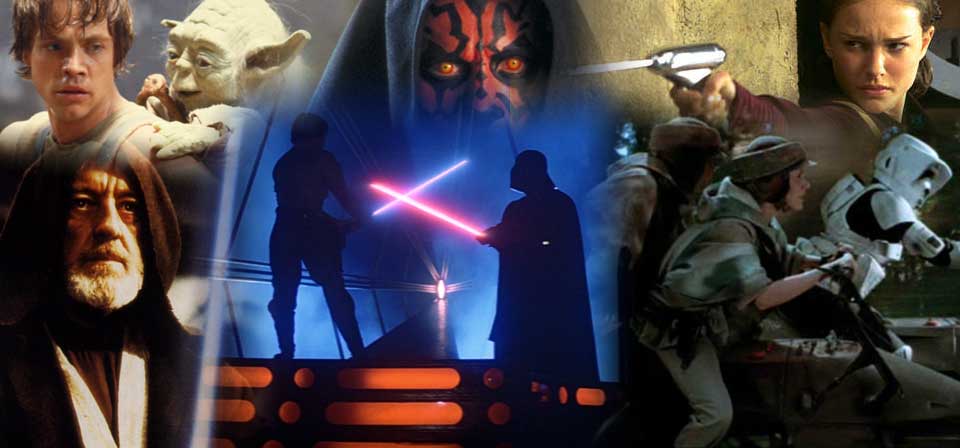
The myth and magic of Star Wars:
Is it over?
By the most empirical of measures, it doesn’t look like anything can kill Star Wars. From another angle, one could equally ask: At this late date, can anything revive Star Wars?
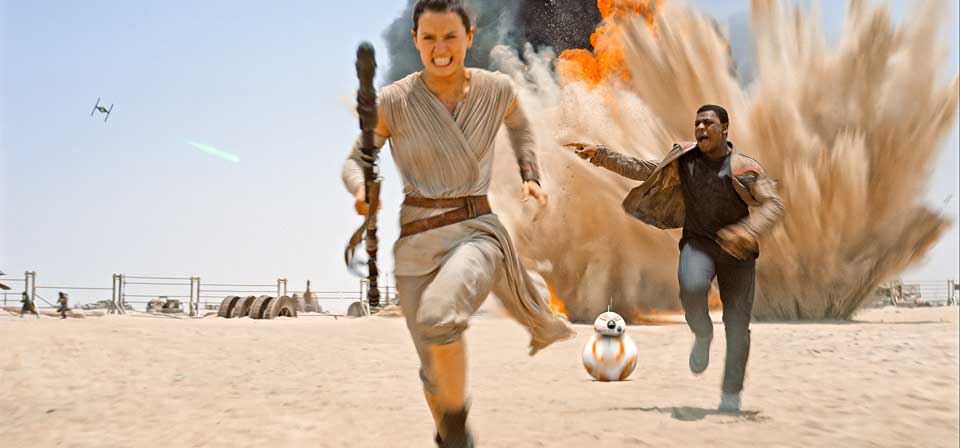
Star Wars: Episode VII – The Force Awakens (2015)
I smiled and laughed through much of the film. Why don’t I love it more? Why did The Force Awakens make almost no lasting impression on me?
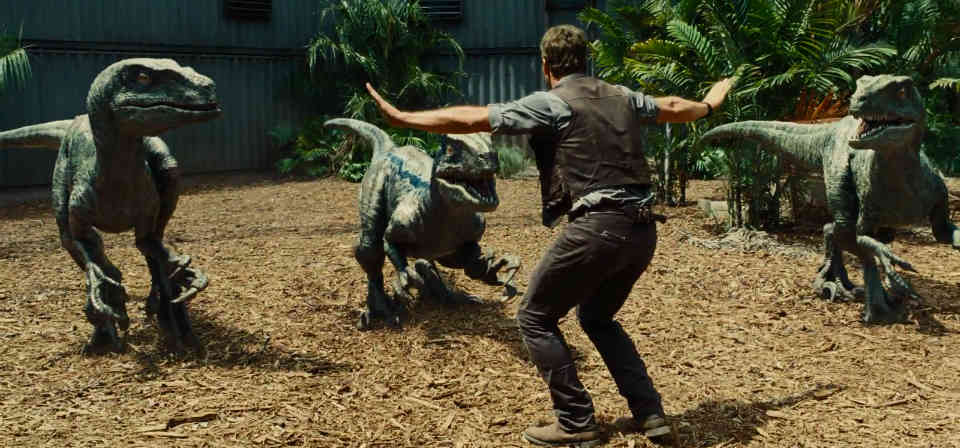
Jurassic World (2015)
Pratt more than delivers. You could almost say he manages to stand in for Sam Neill, Jeff Goldblum and Laura Dern. He’s got Neill’s toughness, Goldblum’s humor and Dern’s down-to-earthness. His character, Owen Grady, is Jurassic World’s velociraptor trainer, and in a terrific early set piece Pratt persuades me that he’s capable of standing up to three raptors armed with nothing but charisma and nerve.
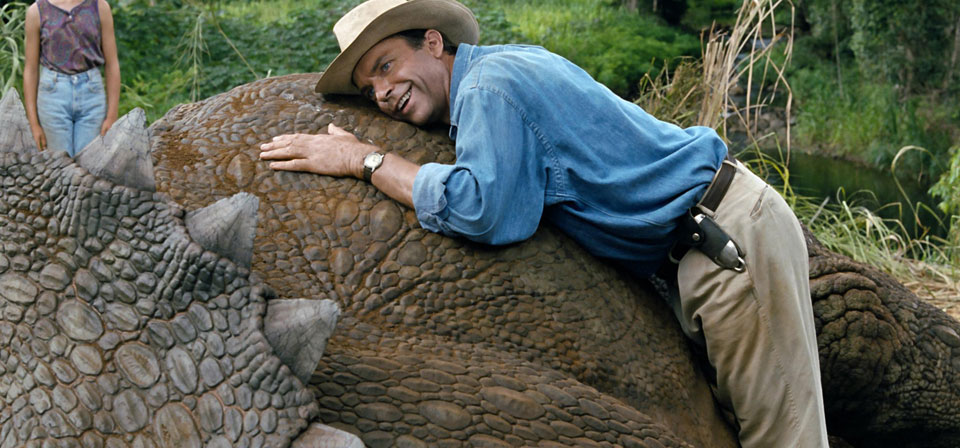
Jurassic Park (1993)
In the twenty-odd years since Jurassic Park pioneered the use of photorealistic computer-animated living creatures integrated into a live-action film, computer animation has become even more prevalent. Yet in all that time, it’s hard to think of a single blockbuster spectacle that uses computer imagery to achieve a similar sense of awe and grandeur.
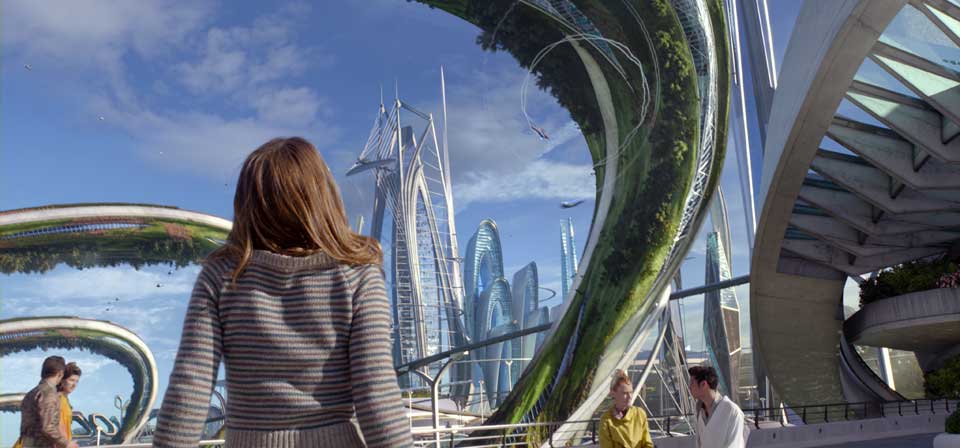
Tomorrowland (2015)
Tomorrowland argues that the future is as dark or as bright as we choose to make it; that artists, scientists and dreamers can save the world; that the dystopian post-apocalyptic nightmares dominating popular culture are killing us, and are no more inevitable or realistic than the Space-Age techno-optimism of Disney’s Tomorrowland and EPCOT, Roddenberry-era Star Trek and even The Jetsons.
![The Hobbit: The Battle of the Five Armies [video]](/uploads/articles/hobbit3_wVjz2vU.jpg)
The Hobbit: The Battle of the Five Armies [video]
“Will you follow me … one last time?” Well, if you promise it’s the last time.
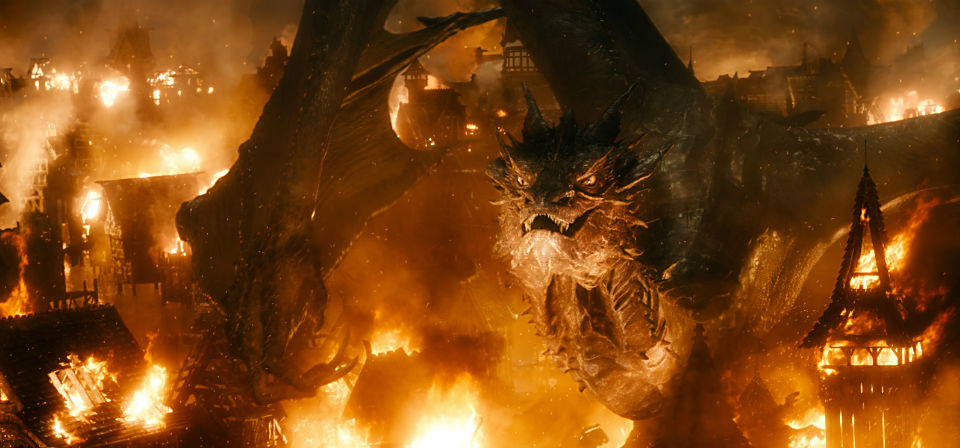
The Hobbit: The Battle of the Five Armies (2014)
What I can say is that The Hobbit: The Battle of the Five Armies (a title strangely stuffed with too many the’s, at a time when movie titles often dispense with articles) includes — amid overinflated spectacle and cynical fan service — some of the best stuff of any of this prequel trilogy.
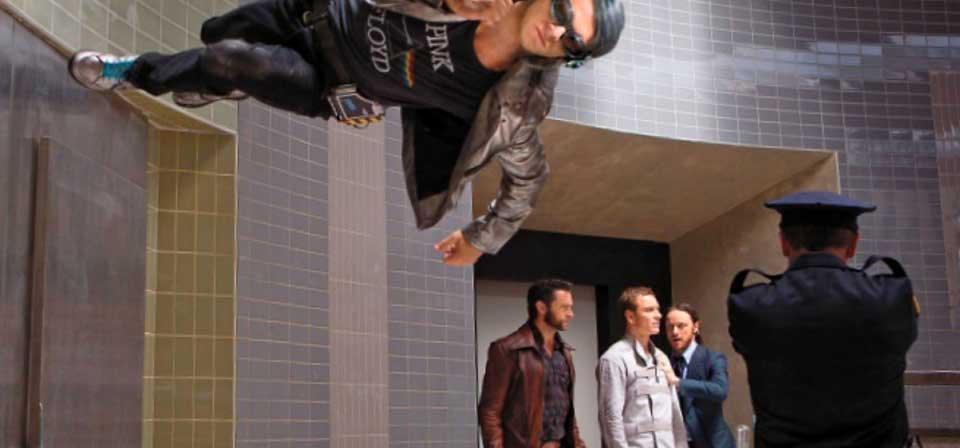
X-Men: Days of Future Past (2014)
X-Men: Days of Future Past is one of the geekiest comic-book movies ever made — and one of the best. It’s easily the best superhero movie since The Avengers — and, like The Avengers, it plays as a triumphant climax to an uneven series of earlier films.
Hidalgo (2004)
(Review by Jimmy Akin) Hidalgo is the story of a horse — and the cowboy who rides him.
The Hobbit: The Desolation of Smaug (2013)
Now, two installments into the epically epic trilogification of Tolkien’s slender fairy tale for children, it seems Jackson and company have only one abiding goal: to keep one-upping themselves with ever more preposterous action sequences, nastier violence and more inappropriate humor.
The Wizard of Oz [video]
Digitally remastered from the original negatives, painstakingly restored, The Wizard of Oz celebrates its 75th anniversary in style. Here’s my “Reel Faith” 60-second tribute to this beloved classic.
Over the Rainbow: The Wizard of Oz Turns 75
So many songs about rainbows and what’s on the other side? What was Kermit talking about? There’s only one song like that … and one movie that embodies the childhood magic Jim Henson wanted to evoke.
The Hobbit: An Unexpected Journey (2012)
There is an early moment in The Hobbit: An Unexpected Journey that captures the evocative poetry of Tolkien’s songs — something that The Lord of the Rings films, for all their achievements, never did. By the time the credits roll, that moment feels like it belonged in a very different film.

Finding Nemo (2003)
(New review for 3-D rerelease) Andrew Stanton’s Finding Nemo is the best father-son story in all of Hollywood animation, and maybe animation generally. It’s also a stunningly gorgeous film that exploits the potential of computer animation like no film before it and few films after it.
Wrath of the Titans (2012)
“Let’s have some fun,” says one god to another, suggesting that they “put on a show.” The moment comes late in Wrath of the Titans. Very, very late. I don’t remember the response, if any, but “Why start now?” would have been appropriate.
John Carter [of Mars] (2012)
Burroughs didn’t invent science fiction, but he perhaps created a genre of serial sci-fi fantasy adventure, with an idealized action hero going from one extraterrestrial adventure to another. Carter’s closest literary ancestor may be Sinbad from One Thousand and One Nights, which is saying something. Buck Rogers, James Kirk and Luke Skywalker are all his descendants, and Jake Sully — the hero of Avatar, which really is a patchwork borrowing from everything Burroughs inspired — is perhaps more indebted to John Carter than any other character in history.
The Grey (2012)
The Grey is a thoughtful, tough-minded little tale of survival and attrition that sets its sights a bit further than its firepower takes it.
The Adventures of Tintin: The Secret of the Unicorn (2011)
Tintin in the comics was the perpetual small-town boy next door. Tintin in the movie is like the boy next door who’s been watching “Mantracker,” “Man vs. Wild” and “Mythbusters” for so long that he’s completely jaded to reality.
Cowboys & Aliens (2011)
Putting Daniel Craig and Harrison Ford in Stetsons is clearly an excellent idea. Both men have faces made for Westerns, rugged and rough-hewn. There is a sense of stoic reserve and working-class grit about them; neither is the sort of man one can only imagine being an actor, or leading a life of privilege.
Harry Potter and the Deathly Hallows: Part 2 (2011)
Here at last, in the final chapter, the Harry Potter franchise rouses itself toward something approaching greatness.
Pirates of the Caribbean: On Stranger Tides (2011)
Was Catholic novelist Tim Powers’ 1987 historical fantasy-adventure novel On Stranger Tides in some way the inspiration, or an inspiration, not only for this fourth Pirates of the Caribbean flick, but for the whole franchise?
Sanctum (2011)
The shocking thing about Sanctum’s fictional survival story, relocated to Papua New Guinea, is not that it kills off one expedition member after another, often quite brutally. The shocking thing is how callously it treats their lives. More than one team member is euthanized by his fellows, submerged and drowned after sustaining catastrophic injuries.
The Chronicles of Narnia: The Voyage of the Dawn Treader (2010)
Is it possible that the makers of The Voyage of the Dawn Treader have made the best film in the series to date while charting a course even further from the book? I think it is. Perhaps it’s even because the film diverges from the book to the extent that it does that I’m able to regard the film more for what it is than for what it isn’t.
Harry Potter and the Deathly Hallows: Part 1 (2010)
The seventh Harry Potter movie, based on the seventh and final book, is here at last, yet the saga is not over. Extending their biggest cash cow of the millennium into next year, Warner Bros. has split Harry Potter and the Deathly Hallows in two, with Part 2 coming next year, almost a full decade after the series started.
Tales From Earthsea (2006)
Does Tales From Earthsea, the latest Studio Ghibli release brought to North American theaters by Disney, have the Miyazaki touch? Well, yes and no.
Prince of Persia: The Sands of Time (2010)
Are there five less inspiring words in the English language than “based on a video game”?
Robin Hood (2010)
Once again a peasant hero reminds us that no man is a knight or peasant but thinking makes him so, and a blacksmith or a stonemason can, and in all likelihood will, shape the destiny of nations. Would you be astonished to learn that there is a proto-feminist heroine who dons armor for the climactic battle? That not only is Richard the Lionheart’s brother John a degenerate, perfidious schemer, Richard himself (briefly seen at the end of Kingdom of Heaven at the outset of his crusade) is a cruel and venal marauder, as bereft of honor as of funds?
Clash of the Titans (2010)
The gods of classical mythology have always been selfish and capricious, but in a tempestuous, grand, passionate style, sort of like “Dallas” in heaven. In the new Clash of the Titans, the gods are about as grand and passionate as “The Simpsons,” and not a tenth as interesting. The original 1981 Clash of the Titans gave us Zeus portrayed by Laurence Olivier with a sort of dissolute patrician dignity. As played by Liam Neeson in the remake, he’s merely grumpy and vacillating. No wonder his half-human son Perseus (Sam Worthington) keeps telling anyone who will listen that he’s a man, not a god.
The African Queen (1951)
Crocodiles, tsetse flies, mechanical difficulties, African rains and burning sun, sickness, an erratic helmer — all these and more plagued the shooting of The African Queen, no less than the onscreen journey of the African Queen down the Ulonga–Bora River during the first World War.
Avatar (2009)
James Cameron’s Avatar is a virtual apotheosis of Hollywood mythopoeia. It is the whole worldview and memory of contemporary Hollywood, given shape in a narrative and pictoral form that is stunning in its finality and grandeur. It is like everything and there is nothing like it.
Harry Potter and the Half-Blood Prince (2009)
Potter fans, whether they’ve kept up with the books or not, will find that the latest film continues the trajectories of recent installments — it’s darker, more tragic and more romantic — while setting the stage for the final battle, now planned for two movies.

Up (2009)
As wonky as the proceedings get, director Pete Docter (Monsters, Inc.) and screenwriter and co-director Bob Peterson (Finding Nemo) never entirely lose touch with the ragged human emotions underlying the story. There’s an obvious metaphor in the film itself for the strange blend of realism and zaniness, partly tethered to solid ground, partly twisting in the capricious winds of whimsy.
Indiana Jones and the Kingdom of the Crystal Skull (2008)
Raiders of the Lost Ark is such a tour de force homage to the serial adventures of yesteryear that viewers who know nothing of those old cliffhangers are swept up in its nostalgia. Kingdom of the Crystal Skull plays to nostalgia for the earlier Indiana Jones films. In that capacity, it delivers more or less what one would expect, disposable popcorn entertainment and a reunion with a few old friends. Enjoy it for what it is, but don’t hope for more.
The Chronicles of Narnia: Prince Caspian (2008)
If the first Narnia film got perhaps two-thirds of Lewis’s intended meaning, Caspian is lucky if it gets a quarter. … The upshot is that Caspian is a good-looking fantasy film with some appealing eye candy and comparatively little to do with the book, beyond basic themes of good versus evil and rather generic faith. On that level, if you can put Lewis out of your mind, it’s a pretty good ride.
Iron Man (2008)
Smart, sardonic and more than a little silly, Iron Man is a successful super-hero movie that never takes itself too seriously.
The Golden Compass (2007)
Overarching all of this is the depraved caricature that the books call “the Church” or “the Magisterium,” but is referred to in the film solely by the latter, less familiar term, which many viewers won’t recognize as a real-world reference to the teaching authority of the Catholic Church. Obsessed with preserving “centuries of teaching” from the dangers of “heresy” and “freethinkers,” by deadly means if necessary, Pullman’s Magisterium is not just oppressive but essentially equivalent to the forces of darkness, akin to Tolkien’s Mordor or the Empire in Star Wars.
Harry Potter and the Order of the Phoenix (2007)
The level of magical eye candy is noticeably lower than previous installments… On the other hand, Ron and Hermione, though probably short-changed compared to the book, are better used here than in the previous film. Best of all is Harry’s leading role in Dumbledore’s Army, marking a major advance in proactive engagement from a protagonist who for too much of the first four chapters has been largely passive.
Fantastic Four: Rise of the Silver Surfer (2007)
Perhaps this is what is most fundamentally wrong with the Fantastic Four franchise: None of these allegedly “fantastic” heroes has any gravitas, any actual heroic weight or depth of character. There’s nothing particularly noble, compelling or even interesting about them. Far from inspiring admiration, they don’t rise even to the level of thinking, acting and relating like grown-ups.
Pirates of the Caribbean: At World’s End (2007)
If Dead Man’s Chest was inspiration gone amok, At World’s End is more — much, much, much more — of the same, only without the inspiration. In every respect it outdoes its predecessor, except in charm, entertainment and fun. Add Pirates of the Caribbean to the roster of franchises foundering on the rocks the third time out.
Spider-Man 3 (2007)
Spider‑Man 3 is a movie stuffed to bursting — with action, plotlines, characters, humor, energy, moods, spectacle and certainly inspiration. Like its web-headed hero careening crazily through the canyons of Manhattan at the end of a web-line, the film swings breathlessly and without warning from one thing to another, from breakneck excitement to outrageous silliness to comic-book morals about responsibility, sacrifice and now even vengeance and forgiveness.
Captain Horatio Hornblower (1951)
Directed by Raoul Walsh (The Thief of Bagdad) from a screenplay adapted by Forester himself from his first three novels, the film deftly balances some of the best age-of-sail sea battles ever filmed with a love-interest storyline in which Hornblower finds himself unexpectedly taking on a female passenger, Lady Barbara Wellesley (Virginia Mayo).
Apocalypto (2006)
Gibson is a consummate filmmaker, and the action is never less than riveting. Yet as the film repeatedly ratchets up the wince factor beyond what seems necessary or appropriate, it’s hard not to feel that suffering has been reduced to spectacle.
Déjà Vu (2006)
If it isn’t the brilliant film it could have been, Déjà Vu still contains enough flashes of that film to make it entertaining while you’re watching it. On reflection, though, it feels a bit like a shell game in which the conjurer himself has lost track of where the pea is supposed to be.
Pirates of the Caribbean: Dead Man’s Chest (2006)
The Raiders comparison is more apt here than in the original, where the swordplay and such was more energetic and well-done than inspired. The sequel takes the slapstick swashbuckling to a completely new level, evoking the ingenuity and physical comedy of a Buster Keaton or Jackie Chan set piece, crossed with the Rube Goldberg logic of a Chuck Jones cartoon.
Superman Returns (2006)
From the rousing fanfare of the classic John Williams score to the comic book–inspired opening credits, it’s clear that Superman Returns means to be nothing less than the film that Superman III could have and should have been, but wasn’t. Except it’s actually better than that.
Superman II (1981)
Superman II isn’t perfect, but in the annals of comic-book movies it remains an indispensable touchstone.
X-Men: The Last Stand (2006)
Expressions like “Good things come in threes” and “Third time’s the charm” may have their place in the world, but when it comes to comic-book movies, so far at least, anything after two is all downhill.
Nanny McPhee (2005)
Mary Poppins meets Lemony Snicket in Nanny McPhee, adapted by star Emma Thompson from Christianna Brands’s Nurse Matilda stories about a magical nanny who knows just the medicine for a family of exceedingly naughty children, and doesn’t bother about the spoonful of sugar to help it go down.
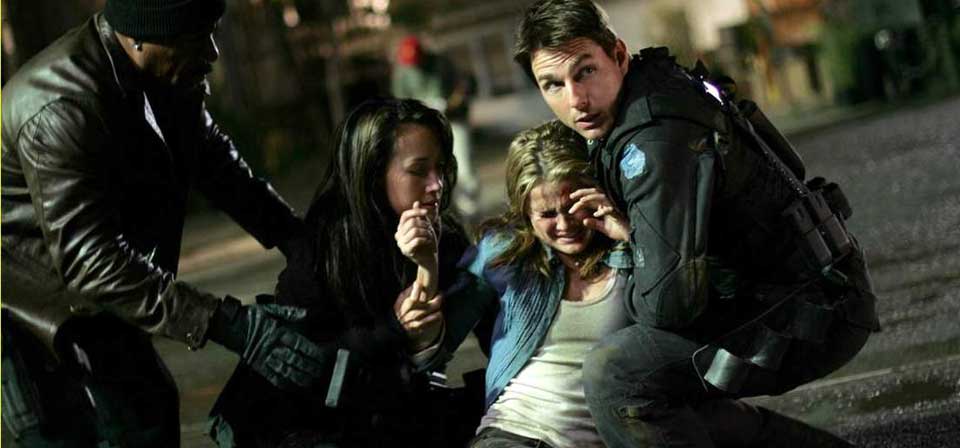
Mission: Impossible III (2006)
Despite its flaws, M:I‑III is competent, disposable entertainment. There’s nothing here that really grabs you like the first film’s CIA break-in, but it doesn’t leave a sour taste like Woo’s M:I‑II. Even so, in the post-007 world of Jason Bourne, that may not be enough.
Eight Below (2006)
If Snow Dogs is a fairly typical example of the conventional Hollywood idea of a live-action family film, Eight Below is a typical example of a new trend in family films that includes National Treasure, Hidalgo, Two Brothers, Fantastic Four and The Legend of Zorro. This is a good thing, but not yet good enough.
King Kong (2005)
Peter Jackson’s King Kong is one of those mad movies, like Baz Luhrmann’s Moulin Rouge! or Tim Burton’s Charlie and the Chocolate Factory, that fully justifies and deserves all the best and worst that can be said for or against them.
The Chronicles of Narnia: The Lion, the Witch and the Wardrobe (2005)
One of the most magical effects in Andrew Adamson’s The Lion, the Witch and the Wardrobe isn’t rippling computer-generated fur, ice castles, or battle scenes. It’s the wide-eyed wonder and delight on the face of young Lucy Pevensie (Georgie Henley) as she passes beyond the wardrobe for the first time into the winter wonderland of the Narnian wood.
Harry Potter and the Goblet of Fire (2005)
The fourth of seven projected films based on J. K. Rowling’s ongoing adventures of the boy wizard, Harry Potter and the Goblet of Fire represents the midpoint of the series and of Harry’s schooling at Hogwarts School of Wizardry and Witchcraft.
Zathura (2005)
Light on plot and story logic but strong on narrative thrust and fantastic imagery, it’s the most effective of the three films… Alas, Zathura is also a family film of the contemporary family as well as for it.
The Legend of Zorro (2005)
More precisely, it’s a “funny family action film” in the Fantastic Four mold — that is, a movie whose key qualification as kid entertainment is that it isn’t good enough for grown‑ups. Too bad. Our kids deserve better. For that matter, so do we.
The Mask of Zorro (1998)
Thrilling, heartbreaking, witty, romantic, and largely family-friendly, The Mask of Zorro is possibly the best swashbuckler of its decade, a film at once true to the spirit of the classic period actioners and also thoroughly of its own time.
Serenity (2005)
For long-suffering “Firefly” fans, Serenity is at last a precious opportunity to find out what happens next, not to mention to learn the answers to nagging questions left hanging by the series’ abrupt demise — a journey that is at once thrilling, rewarding, heartbreaking, and wistful. For non-fans, Serenity is a delirious excursion into a world whose setting, characters and relationships are richer and more elaborate than any one-shot movie is likely to be.
The Three Musketeers (1921)
Danny Kaye in that classic swashbuckling satire The Court Jester may well have been thinking of the great Douglas Fairbanks when he described his own character with the words: “He never walks when he can leap, he never flees when he can fight. He lives for a sigh, he dies for a kiss, he lusts for a laugh!”
Ben-Hur [A Tale of the Christ] (1925)
At nearly 2½ hours long, the 1925 version is still an hour shorter than the 1959 version, yet the story is essentially the same, and the scale similarly impressive.
Ben-Hur [A Tale of the Christ] (2003)
In 2003, Charlton Heston reprised his greatest role, if in voice only, in an animated made-for-TV version of Ben-Hur from the director and producers of the animated “Greatest Heroes and Legends of the Bible” series.
Sky High (2005)
Less than a month after Fox’s dumb, trashy Fantastic Four somehow passed itself off as a family-friendly superhero comedy comes Disney’s Sky High, a film that actually fits the bill.
Star Trek III: The Search for Spock (1984)
The Search for Spock may be the unappreciated middle child of the Trek franchise, but it’s still one of better and more indispensable episodes.
Star Trek VI: The Undiscovered Country (1991)
The original Trek crew’s real last hurrah, Star Trek VI: The Undiscovered Country is a rousing sendoff for Kirk, Spock, and Bones, and a fitting transition from the original series’ Cold-War milieu to the Next-Generation age of engagement.
Star Trek IV: The Voyage Home (1986)
With its time-traveling setting in the familiar milieu of the mid-1980s and its crowd-pleasing celebration of whales and conservationism, Star Trek IV: The Voyage Home is the most successful and widely appealing of the Star Trek films, and also the most idiosyncratic.
Star Trek II: The Wrath of Khan (1982)
One of the strongest and most popular entries in the Star Trek film franchise, The Wrath of Khan has everything you could ask for in a good sci‑fi action-adventure film: sympathetic, well-drawn heroes, a terrific villain (Ricardo Montalban as Khan), exciting outer-space showdowns, sci‑fi wow factor (the Genesis effect), and a touch of reflective depth (the Enterprise crew finally faces up to age and mortality, and questions about the wisdom and consequences of playing God are hinted at).
Star Trek: Nemesis (2002)
(Written by Jimmy Akin) The main cast is no longer trapped in amber — never changing their relationships, never getting promoted, never leaving the Enterprise. They’ve become unstuck. It’s a sign of things to come.
Swiss Family Robinson (1960)
The film simplifies the original story in many ways, reducing the book’s four sons to three and the half-dozen or so homesteads and plantations the Robinsons build to the one famous treehouse. Wyss’s fantastical menagerie, which included penguins, kangaroos, flamingos, lions, and boa constrictors living side by side, is only slightly restrained by a century and a half of scientific advancement, and the book’s strong element of religious devotion and moral discipline is largely reduced in the film to a moment of silent prayer on the beach.
Lancelot of the Lake (1974)
More, it is a tale of fellowship undone not first of all by the treachery of enemies but by the frailty of human nature itself, even of the most trusted intimates. Perhaps that’s partly why classic Hollywood forayed more successfully into Sherwood Forest and Zorro’s California than Camelot.
Fantastic Four (2005)
How bad is Fantastic Four? So bad that in desperation execs have resorted to trying to spin it as a "funny family action film," as one studio rep put it. It’s the Kangaroo Jack strategy: When your dumb, trashy film clearly isn’t good enough for adolescents, let alone adults, reposition it as a kiddie flick. It’s an insult to family audiences. Our kids deserve better than Hollywood’s garbage.
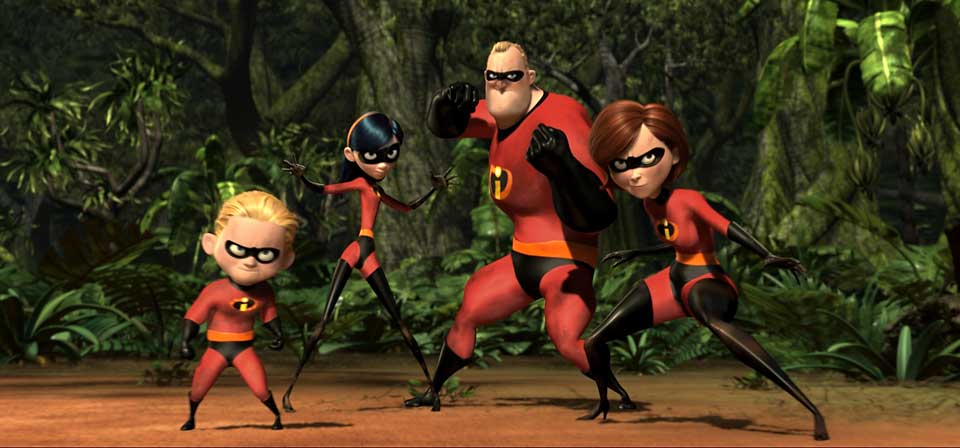
The Incredibles (2004)
The Incredibles is exhilarating entertainment with unexpected depths. It’s a bold, bright, funny and furious superhero cartoon that dares to take sly jabs at the culture of entitlement, from the shallow doctrine of self-esteem that affirms everybody, encouraging mediocrity and penalizing excellence, to the litigation culture that demands recompense for everyone if anything ever happens, to the detriment of the genuinely needy.
War of the Worlds (2005)
Individual set pieces are riveting, and one seldom doubts that if alien tripods were actually wreaking havoc on the Earth, this is indeed very much what it would be like. Afterwards, though, one is left with little more than ashes.
Batman Begins (2005)
It’s tempting to call Batman Begins the Citizen Kane of super-hero movies; at any rate, it’s the closest thing so far.
Star Wars: Episode II - Attack of the Clones (2002)
It doesn’t help that this is now the second Star Wars movie in a row in which the "wars" alluded to in the series title are still basically in the future (one climactic skirmish aside). Lucas should never have gotten bogged down in political debate, let alone given two whole films of it.
Star Wars: Episode I - The Phantom Menace (1999)
It’s not just that the banter and camaraderie of Luke and Han and Leia was so much more fun than the often wearying interactions of Anakin and Amidala and young Obi-Wan — though that’s part of it. More importantly, the stories themselves largely lack the strong center of good versus evil that was the heart of the original trilogy.
Star Wars: Episode III – Revenge of the Sith (2005)
Crippled as he is by the decisions of the first two films, Lucas still manages to invest the final chapter of his sprawling space opera with the grandly operatic spirit of the original trilogy. It’s still cornball, yes, and with all the usual weaknesses. But Episode III at last has heart.
Star Wars [Episode IV – A New Hope] (1977)
An orphaned hero. An imprisoned princess. A wise old hermit. A magic sword. A fearsome dark lord. Such conventions are the stuff of myth and romance — yet, inexplicably, the first Hollywood film to give these mythic archetypes their due was not some Arthurian romance or epic costume drama.
Star Wars: Episode VI – Return of the Jedi (1983)
Thematically, where the first Star Wars movie offered a simple vision of good triumphing over evil, and The Empire Strikes Back expressed the problem of evil and the necessity of sacrifice, Return of the Jedi tackles nothing less than resisting temptation, compassion for enemies, and the possibility of redemption for even the most evil.
Steamboat Bill, Jr. (1928)
The film’s great claim to fame lies entirely in its wholly unexpected third act, which essentially jettisons the amiable comic plot driving the first two-thirds of the film in favor of a wildly inventive and increasingly audacious series of stunts and set pieces as Keaton battles a raging tornado.
Kingdom of Heaven (2005)
The story, in fact, could largely be described as the failure of moderate Christians to restrain fanatical Christians from oppressing innocent Muslims, thereby provoking justifiable Muslim retaliation against the Christians, both fanatics and otherwise. Yet Saladin himself is not an uncomplicated noble figure. As he prepares to lay siege to Jerusalem, he explicitly rejects the possibility of showing mercy, relenting only when Balian fights him to a standstill.
The Lord of the Rings: The Return of the King (2003)
It’s hard to overstate the soaring achievement of Peter Jackson and company in The Return of the King, the third and final chapter of their historic adaptation of The Lord of the Rings. To call it the grandest spectacle ever filmed is no exaggeration; it may also be the most satisfying third act of any film trilogy, completing what can now be regarded as possibly the best realized cinematic trilogy of all time.
Spartacus (1960)
Though pre-Christian, Spartacus prefigures and provides historical context to the Gospel story in intriguing ways — most obviously in the bold climax, the film’s greatest strength. Spartacus doesn’t entirely escape the melodrama, cheesiness, and anachronistic hairstyles that afflict the genre and period, but the comparative frankness of the politics, sexuality, and violence, and especially the downbeat third act and memorable finale give it a dramatic heft beyond its predecessors. The decadence and corruption of Rome, too, is vividly contrasted with the wholesome, family-oriented society of the rebel slaves.
Napoléon (1927)
It is an extraordinary artifact from another culture, a mythology as remarkable and as alien as the Epic of Gilgamesh or the Icelandic Eddas. For students of silent film, this is one of those indispensable landmarks you must see before you die.
Ivanhoe (1952)
Director Richard Thorpe and star Robert Taylor would re-team the following year for the Arthurian epic Knights of the Round Table, but that film is a pale imitation of Ivanhoe, which boasts better spectacle and action (highlights include the opening tournament, the rousing seige sequence that is the film’s centerpiece, and a gripping climactic duel scored by ominous drums), a more interesting romantic triangle, and better villains scheming to usurp the king’s throne.
Ivanhoe (1982)
The best version is the 1982 TV movie starring Anthony Andrews (“A.D.”) as Ivanhoe, Olivia Hussey and James Mason (“Jesus of Nazareth”’s Virgin Mary and Joseph of Arimathea) as the Jewess Rebecca and her father Isaac of York, and Sam Neill (Jurassic Park), John Rhys-Davies (The Lord of the Rings), and Stuart Wilson (The Mask of Zorro) as villainous Norman knights.
King Solomon’s Mines (1950)
Recent knock-offs have been especially lame: A 2004 Hallmark Channel version starring Patrick Swayze shows some initial promise before losing its way in the second act amid boring plot twists and PC alternative spirituality (lots of talk about “having faith in the ancestors,” and the evil, ancient witch Gagool is reinvented as a benevolent young shamaness!). About Sean Connery’s recent turn as Haggard hero Alan Quatermain in the almost completely inspiration-free League of Extraordinary Gentlemen, not to mention the 1985 version, a campy Raiders of the Lost Ark wannabe starring Sharon Stone, the less said, the better.
King Solomon’s Mines (1937)
Lewis would have been left equally cold to subsequent screen versions of Haggard’s story, all of which give Haggard hero Allan Quatermain a female foil (who is always, except here, a love interest), and none of which capture the deathly spell of the mountain tomb (though the classic 1950 version is the least objectionable on this point).
Robots (2005)
Robots combines the visionary alternate world-building of Monsters, Inc., the flair for gadgetry and gimmickry of an old Fleishers cartoon, and most sneakily of all, the toybox nostalgia of the Toy Story movies, with cleverly worked-in toy and game references — “Operation,” Slinky, Wheelo — that will have adults grinning with recognition.
The Princess Bride (1987)
Rob Reiner’s great cult classic The Princess Bride is one of those rare satiric gems, like The Court Jester and Galaxy Quest, that doesn’t just send up a genre, but honors it at the same time, giving us the excitement and pleasure of the real thing as well as the laughs of a comedy.
Lemony Snicket’s A Series of Unfortunate Events (2004)
If you prefer movie reviews about pleasant and uplifting films in which goodness is suitably rewarded, evil is suitably punished, and children are not placed in excessive peril or disagreeable circumstances, you may wish to read some other review.
Flight of the Phoenix (2004)
This provocative comeuppance for can-do American spirit is thrown to the winds in the remake, which from the outset establishes pilot Frank Towns (Dennis Quaid) and his co-pilot A.J. (Tyrese Gibson in the Attenborough role) as bullying, swaggering creeps with no redeeming traits who exist in order to be taught a lesson. They’re gratuitously abusive to the ragtag team of abruptly unemployed oil-riggers they’ve come to evacuate. Their arrogant repartee in the opening minutes is so full of leering sexist humor (Frank’s the sort of guy who can’t even buckle his seat belt without making a lewd remark about it) that by the time A.J. observes of the massive sandstorm into which they’re flying, "That’s a big one, Frank," we can tell it must be serious, since Frank makes no crass response.
National Treasure (2004)
Nicolas Cage stars as heir to a family of treasure hunters seeking the riches of King Solomon’s temple, discovered by the Crusaders and hidden by the Knights Templar and the Freemasons, who planted clues on the back of the Declaration of Independence.
House of Flying Daggers (2004)
In the end, though, it turns out that the House of Flying Daggers is something the film doesn’t actually care about that much. So much is this the case, in fact, that the last time we hear tell of them, the warriors called the Flying Daggers are about to get into this huge climactic battle with the enemy soldiers, whom we see advancing slowly into the bamboo forest where the Flying Daggers are hiding… at which point the story cuts to another plot thread, never to return.
The Searchers (1956)
The reputation of John Ford’s The Searchers as a classic but troubling Western in which John Wayne plays an Indian-hating racist is so widely accepted that it’s a bit of a surprise to discover that the film, and the character, are in fact more complex than the reputation suggests.
King Arthur (2004)
Even in the silent era, with Douglas Fairbanks playing every legendary hero from Zorro to Robin Hood to D’Artagnan, seeking adventure everywhere from the Spanish Main (The Black Pirate) to Arabian Nights territory (The Thief of Bagdad) to South America (The Gaucho), King Arthur was overlooked.
Lassie Come Home (1943)
The obstacle to this duty, of course, is that Joe’s father Sam (Donald Crisp) is eventually forced out of financial necessity to sell Lassie to the wealthy Duke of Rudling (Nigel Bruce). However, Lassie twice escapes from the the duke’s disagreeable handler Hynes (J. Patrick O’Malley) in order to keep her appointment with Joe, and eventually the duke takes Lassie to an estate in Scotland, over a thousand miles from her home.
Peter Pan (1953)
For millions of children and adults, Disney’s Peter Pan is THE Peter Pan, as well as a defining moment in Disney animation, giving the studio its logo mascot, Tinker Bell.
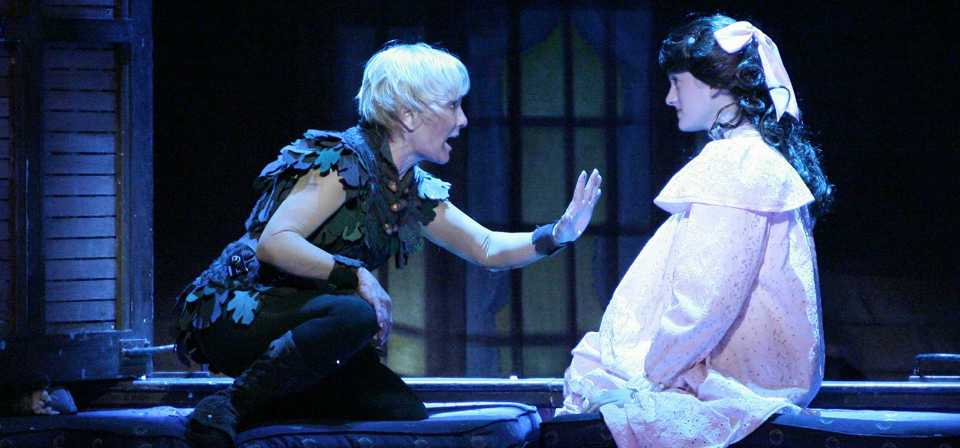
Peter Pan (2000)
It may seem heresy to baby boomers with fond memories of Mary Martin singing and flying on NBC, but this beautifully produced A&E restaging of the musical, starring gymnast-turned-actress Cathy Rigby, eclipses the beloved 1960 Martin kinescope in almost every way.
Peter Pan (2003)
One of the functions of fairy tales is to reflect in an imaginative way truths that, were they presented literally, children might not be ready for, but which they can on some level apprehend and assimilate in this form, and be in some way more prepared emotionally for life. Fairy tales help children grasp what life expects of them, what dangers, adversities, and opportunities they will face. From them children can begin to learn the prudence to avoid the dangers, the fortitude to face the adversities, and the enterprise to seize the opportunities.
Peter Pan (1924)
Continuing a stage convention that would extend to subsequent film versions, Pan is played by a petite woman, teenaged Betty Bronson (hand-picked by Barrie himself), who brings tomboyish energy and dash to the role. Ernest Torrence sneers with foppish malevolence as Captain Hook, and Mary Brian makes a charming Wendy. The stage flying effects work just as well onscreen, and George Ali reprises his delightful costumed animal performances from the stage as Nana and the crocodile.
The Thief of Bagdad (1940)
In this version, the romantic lead who falls in love with the princess is not the titular thief, but a beggar named Ahmad (John Justin) who is actually the rightful king of Bagdad, but has been deposed by his treacherous Grand Vizier Jaffar (Conrad Veidt). The thief, on the other hand, is a mischievous, resourceful lad named Abu (Sabu).
The Thief of Bagdad (1924)
Rivaled only by the awesome Babylonian segments of D. W. Griffith’s Intolerance, Douglas Fairbanks’ lavish, extravagant The Thief of Bagdad ranks as the very pinnacle of silent-era spectacle.
Sinbad: Legend of the Seven Seas (2003)
With its swashbuckling action and blend of traditional and 3D computer animation, Sinbad most resembles Disney’s Treasure Planet — yet for once DreamWorks handily outdoes its archrival, with bravura action set pieces, a surprisingly complex romantic triangle, and an even more remarkably thoughtful exploration of moral issues and character.
Sky Captain and the World of Tomorrow (2004)
There are also plenty of film geeks who know and love the pulp fantasies of the early twentieth century, from Metropolis to the serialized swashbucklers of Buck Rogers and Flash Gordon. Some of these geeks are even creative enough to weave their own fantasies in the spirit of those classic films, even to the point of writing and directing the films themelves, though to date the only film actually made this way, as far as I know, is Star Wars. (Raiders of the Lost Ark, perhaps the ultimate serial-adventure homage, was conceived by George Lucas but written by Lawrence Kasdan and directed by Steven Spielberg.)
Touching the Void (2003)
Forget Cast Away. Forget Alive. Touching the Void, the true story of a pair of daredevil mountain climbers in the Peruvian Andes, may be the most harrowing, dazzling, haunting survival story ever filmed.
Hero (2002)
The story is pure Hong Kong melodrama, set at the dawn of the Chinese Imperial Era in the third century BC. … Yet there’s nothing even marginally conventional about Hero’s overpowering visual splendor, its effulgent riot of color and texture, its overwhelming spectacle of scale.
Hidalgo (2004)
Viggo Mortensen, back in the saddle in his first post-Aragorn role, is entertaining as the laconic, disarmingly soft-spoken cowboy hero called "Far Rider" by the American Indians in honor of his fleet-footed mustang Hidalgo. Remarkably, Disney doesn’t whitewash the more politically incorrect elements of Hopkins’ tale: The Arabs Hopkins meets are sophisticated and well-bred but also imperious, condescending to non-Muslim "infidels," slighting to their women, callous to slave trade, and in some cases duplicitous and murderous — though others are loyal and honorable, and there’s also an explicitly identified "Christian" (i.e., European) character who’s a villain.
Benji Off the Leash! (2004)
Benji Off the Leash is undoubtedly the first dog movie ever made that thinks that a happy ending for a boy and his dog is not for the boy to get to keep the dog, but for the dog to go off to Hollywood to make a motion picture.
Planet of the Apes (1968)
Adapted by Rod Serling from Pierre Boulle’s Swiftian social satire, Planet of the Apes is basically a feature-length "Twilight Zone" episode, with all that that implies for good and ill. There’s an ironic sci-fi reversal of real-world conditions, a rather thin plot padded to fill out the running time, heavy-handed but sincere allegorical moralizing, thought-provoking social satire, and a stunningly imagined climactic twist.
Spider-Man 2 (2004)
This is what a Spider-Man movie should be — freewheeling, rip-roaring, hilarious, heartfelt, over the top.
The Bourne Supremacy (2004)
Jason Bourne (Matt Damon) has come a long way since he was fished out of the ocean with a pair of bullet holes in his body and even bigger holes in his memory. His past is still a blank, mostly, but he’s finally fully in command of his devastating training and skills as a CIA black-ops agent. These days, when he kicks into high gear, it’s by design, not reflex.
2001: A Space Odyssey (1968)
2001: A Space Odyssey doesn’t just depict a quantum leap forward in human consciousness — it practically requires such a leap, on an individual scale, from the viewer. Like the hominid in the first act who looks at a bone and suddenly sees what no hominid has ever seen before, one must watch 2001 in a different way from other films.
Spider-Man (2002)
From its breathless, cartoony title sequence, with the letters of cast members’ names stuck like flies in a vast spiderweb,
Two Brothers (2004)
Annaud’s skill and subtlety elevate what is essentially a simple, fable-like throwback to the sort of live-action feature Disney used to make in the 1950s.
Around the World in 80 Days (2004)
Without a doubt, the best thing about Frank Coraci’s Around the World in 80 Days is the fight scenes.
Stagecoach (1939)
Stagecoach is not the greatest Western of all time, but has been called the first great Western, and played a key role in the status of the Western as the quintessential American genre.
Harry Potter and the Prisoner of Azkaban (2004)
Where its predecessors felt a bit padded and overlong, The Prisoner of Azkaban feels incomplete and overly edited. If the first two films could easily have been tightened up by a half-hour or so, this one left me wishing for the first time that there were an “extended edition” DVD coming, as with the Lord of the Rings films.
Harry Potter and the Chamber of Secrets (2002)
Harry Potter is back, and in this second outing the stakes are higher, the themes darker, the Malfoys nastier, the action grander, the monsters scarier, the gross-outs ickier, the climax stronger, and the movie longer.
Harry Potter and the Sorcerer’s Stone (2001)
Fans of the books will be gratified by a warm rush of recognition at every turn. From the growing anticipation as the mysterious invitations to Harry at the Dursley’s begin their inexorable multiplication, to Robbie Coltrane’s comforting performance as the genial giant Hagrid, to the dazzling Hogwarts grounds, to the exhilarating speed and excitement of Quidditch, the book’s main pleasures have been expertly realized.
Dersu Uzala (1975)
Vladimir Arseniev was an early 20th-century explorer who mapped much of the krai territory of the Russian Far East and studied its indigenous peoples. Based on his memoirs, Akira Kurosawa’s Dersu Uzala tells the story of an unusual friendship between Arseniev (Yuri Solomin) and the nomadic tribal hunter for whom the film is named (Maksim Munzuk).
Shane (1953)
If the Western is the quintessential American mythology, Shane (Alan Ladd in his best-known role) is the Western’s great knight–samurai archetype: stern in battle, mild with women and children, siding with the wronged, honoring marriage.
Shrek 2 (2004)
If Pixar’s Toy Story movies connect with the child in all of us, DreamWorks’ Shrek pictures are aimed squarely at our inner adolescent. I suspect I may be more in touch with my inner child than my inner adolescent.
Shrek (2001)
Loosely based upon a story by children’s author William Steig (Sylvester and the Magic Pebble), Shrek is a satiric, updated fairy-tale love story, sort of like The Princess Bride, if André the Giant had been the hero, and had worn Lou Ferrigno body paint. And if Princess Buttercup did Matrix-style wire-fu and knocked out bad guys.
Troy (2004)
So long is the shadow of The Iliad over the history of Western literature that before considering the merits of Wolfgang Petersen’s Troy it may be helpful to recall that the story of the Trojan War was not only likely told by poets long before Homer, certainly after Homer it has been retold and reworked by numerous poets and writers, including Virgil, Euripides, Quintus, Chaucer, and Shakespeare.
Ben-Hur [A Tale of the Christ] (1959)
The grandest of Hollywood’s classic biblical epics, William Wyler’s Ben-Hur doesn’t transcend its genre, with its emphasis on spectacle and melodrama, but it does these things about as well as they could possibly be done.
Agent Cody Banks 2: Destination London (2004)
Unfortunately, while this sequel is the least morally problematic of Muniz’s three big-screen outings, it’s also far and away the lamest, lacking utterly its predecessors’ fitful humor and excitement. When the high point of your movie involves a Queen Elizabeth lookalike getting down to a youth-orchestra Euro-pop version of Edwin Starr’s "War," something has gone disastrously wrong.
The Missing (2003)
In place of Ford’s iconic but Indian-hating cowboy hero, Howard gives us two white protagonists who are each, in their own ways, the antitheses of the John Wayne character.
Heaven Knows, Mr. Allison (1957)
Like director John Huston’s similarly themed The African Queen, the film finds conflict mixed with romantic tension in a tale of a demure religious woman thrown together with a rugged male loner. Here, though, the complicating factor is not fastidiousness on the part of the religious woman, but the woman’s vocation.

The Court Jester (1956)
Not only does it terrifically succeed where movies like Mel Brooks’ Robin Hood: Men in Tights miserably fail, The Court Jester also as merry, high-spirited, and wholesome as the adventures it parodies, with none of the cynical, anarchic spirit (or content issues) of the likes of Monty Python and the Holy Grail.
Father Goose (1964)
Cary Grant cheerfully plays against a lifetime of typecasting in this modestly entertaining romantic comedy with comic echoes of The African Queen and Heaven Knows, Mr. Allison, directed by Ralph Nelson (The Lilies of the Field).
The Hobbit (1977)
Character design is a mixed bag: Gandalf looks very much himself, but Bilbo is rather cherubic, and the dwarves are uninspired. Worse is Gollum, disappointingly bloated and stiff rather than agile and emaciated, and the dreadfully goblin-like Wood-Elf King. (On the other hand, the Elf-lord Elrond, with his distinguished features and strange crown-halo, is far preferable to Bakshi’s dismally graceless version of the same character.)
The Lord of the Rings (1978)
Notwithstanding this and other weaknesses, this Lord of the Rings is in some respects quite impressive and remains worth a look, especially for Tolkien fans, and perhaps younger viewers not quite old enough for Peter Jackson’s more intense adaptation — though even the Bakshi is darker and more intense than most cartoons. (Younger viewers might also be interested in the animated Rankin-Bass versions of The Hobbit and The Return of the King.)
The Return of the King (1980)
The film hits the most critical plot points, but is clearly aimed at the younger set, with little to interest even the most avid adult Tolkien and/or animation buff. Unfortunately, this style works even less well here than in The Hobbit, which really is a children’s story. Tolkien’s Lord of the Rings is a much more adult work, but Rankin-Bass essentially makes a kid movie out of it. Even so, for kids too young for the Jackson or even Bakshi versions, the Rankin-Bass cartoons might be just the ticket.
Lawrence of Arabia (1962)
One of the cinema’s grandest spectacles, Lawrence of Arabia is at turns exhilarating, devastating, and puzzling as it ponders the mystery of a man who was a mystery to himself.
The Lord of the Rings: The Two Towers (2002)
From the very first sequence of Peter Jackson’s The Two Towers — a bravura opening that stunningly recalls and continues a central sequence from The Fellowship of the Ring — we feel that we’re in good hands. It’s a promise the subsequent three hours deliver on imperfectly.
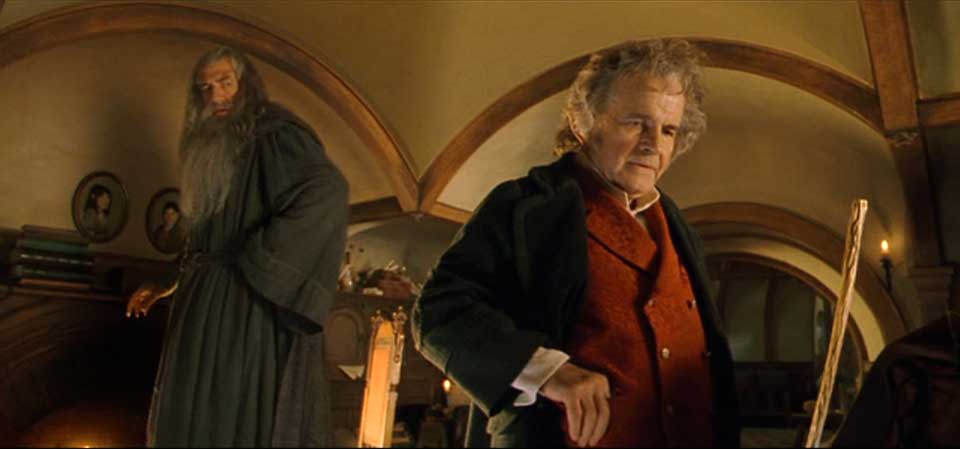
The Lord of the Rings: The Fellowship of the Ring (2001)
There can be no more fitting tribute to Peter Jackson’s The Fellowship of the Ring than to apply to it the words with which C. S. Lewis acclaimed the original book when Tolkien first wrote it: “Here are beauties that pierce like swords or burn like cold iron; here is a [film] that will break your heart.”
The Chronicles of Narnia (1988‑1990)
Beautiful, rugged UK landscapes, splendid old castles and other shooting locations, and some fairly impressive sets help create a sense of authenticity. At the same time, with the earlier episodes especially limited by modest production values, rudimentary special effects, and uneven acting, the Chronicles can’t be held even to the standard of such American TV productions as the Merlin and Arabian Nights miniseries.
Pirates of the Caribbean: The Curse of the Black Pearl (2003)
The most remarkable thing about Pirates of the Caribbean: The Curse of the Black Pearl is neither Johnny Depp’s mesmerizing performance, nor ILM’s literally eye-popping skeletal ghost-ship crew, but the sheer fact that the movie works at all.

Master and Commander: The Far Side of the World (2003)
Like a cannon blast across the bows, Peter Weir’s Master and Commander: The Far Side of the World is a thunderous, almost defiant declaration heralding the arrival of a force to be reckoned with.
Brother Bear (2003)
(Co-written with Suzanne E. Greydanus) Based on a long-unfinished project dating to the New-Age / ultra-PC heyday of Disney’s ’90s renaissance, Brother Bear outdoes even Pocahontas and Atlantis: The Lost Empire with its New-Age mysticism and eco-spirituality gospel message.
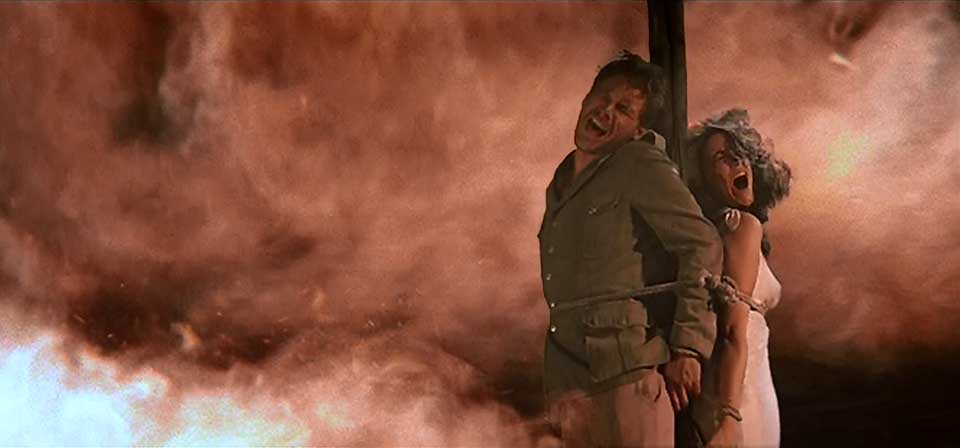
Raiders of the Lost Ark (1981)
Like the Paramount logo mountain peak in the now-famous opening dissolve that started it all nearly three decades ago, Raiders of the Lost Ark towers over the surrounding landscape. It is the apotheosis of its genre, the Citizen Kane of pulp action–adventure, definitively summing up all that came before and setting the indelible standard for all that comes after.
Robin Hood (1973)
Oo-de-lally! As post-Sleeping Beauty Disney animated features go, Robin Hood is a fine entry, better than The Sword in the Stone or The Fox and the Hound but not as good as The Jungle Book or The Many Adventures of Winnie the Pooh.
The Adventures of Robin Hood (1938)
The story is the classic Robin Hood tale, and it’s all here: the fateful shooting of the King’s deer; Robin’s ignominious duckings upon his first meetings with Little John (Alan Hale) and Friar Tuck (Eugene Pallette); Robin’s penchant for entertaining wealthy victims in high Sherwood style before relieving them of their gold; the trap archery contest which a disguised Robin wins by splitting his opponent’s arrow; the return of Richard (Ian Hunter) from the Crusades disguised in monk’s attire.
The Black Pirate (1926)
Fairbanks’s astonishing acrobatics remain dazzling today, and the climactic battle includes some great underwater footage of an aquatic assault on the pirates. This film includes Fairbanks’ most famous and widely copied stunt, riding down a sail on the edge of a knife; but my favorite is the scene in which he cuts loose the corner of a billowing sail and then holds on as the wind carries him up off the deck of the ship and high into the rigging.
Don Q Son of Zorro (1925)
Don Q Son of Zorro, named one of the year’s ten best films by The New York Times, actually outdoes its predecessor, with a stronger and more sophisticated plot, better pacing, more interesting and complex characterizations, grander production values and set design, and more consistent action.
The Mark of Zorro (1920)
You haven’t seen Zorro until you’ve seen Douglas Fairbanks Sr. as Zorro in the 1920 silent swashbuckling classic.
The Mark of Zorro (1940)
Powers can’t match the original Zorro’s astonishing acrobatics and doesn’t try — but the rousing climactic duel against Basil Rathbone’s villainous Captain Esteban, one of the best swordfights ever filmed at that time, almost makes up for it.
Robin Hood (1922)
Silent action king Douglas Fairbanks Sr. is the most exuberantly athletic of Robin Hoods, for sheer physicality perhaps outdoing even Errol Flynn’s definitive performance.
The Count of Monte Cristo (2002)
Like The Mask of Zorro, Monte Cristo balances its anachronistic sensibilities and over-the-top set pieces with genuine emotion and a real moral dimension — even, in Monte Cristo, a spiritual dimension. This is an action movie that’s also a morality play, a tale of injustice and vengeance that actually reckons on God, faith, and divine justice.
X2: X-Men United (2003)
Where other super-hero movies, like James Bond movies, take place in a static universe in which nothing really changes and the essential mythology remains the same, X2 is set in a world in flux. The plot is part of an ongoing story-arc reaching back to
Holes (2003)
Holes manages that rare trick of faithfully evoking what was special about the book without becoming slavish or by-the-numbers. Davis captures the book’s blend of coming-of-age realism, tongue-in-cheek grotesquerie, fantasy, and adventure, and capably navigates the plot’s multiple timelines and settlings.
Superman (1978)
A classic tribute to an American pop-culture icon, Superman is the first great comic-book movie and a nostalgic ode to the ideals of a more innocent time.
Knights of the Round Table (1953)
The story starts a bit stiffly with the tale of Arthur’s rise to power, beginning with the adult Arthur (Mel Ferrer) and rival Mordred (Stanley Baker) meeting at the sword in the stone with their respective advocates, Merlin (Felix Aylmer) and Morgan le Fey (Anne Crawford). Things improve with the arrival of Lancelot (Robert Taylor), who even before meeting Arthur is willing to die for him and his ideals of chivalry, courtesy, and virtue.
Iron Monkey (2001)
Miramax execs would like you to think of Iron Monkey as this year’s Crouching Tiger, Hidden Dragon. It might be more accurate, though, to call it this year’s The Legend of Drunken Master.
Monsieur Beaucaire (1946)
Beaucaire (Hope) is barber to Louis XV of France — until the former’s romantic altercations with a chambermaid named Mimi (Joan Caulfield) inadvertently result in banishment for both Mimi and himself. At the same time, the king finds it expedient to rid the court of the Duc le Chandre, a renowned swordsman and celebrated ladies’ man, by making a political marriage between le Chandre and Princess Maria of Spain (Marjorie Reynolds).
Spy Kids 3-D: Game Over (2003)
If Spy Kids 3-D: Game Over were consistent, that protest would become Juni’s mantra, repeated every thirty seconds or so from that point on until the end of the film. Then again, if Spy Kids 3-D were consistent — about anything at all — it might actually start making some kind of sense.
Spy Kids 2: Island of Lost Dreams (2002)
In the original Spy Kids, dashing spy parents Gregorio and Ingrid Cortez (Antonio Banderas and Carla Guigino) exchanged the glamorous world of espionage for the even greater adventure of raising a family. Their children Carmen and Juni (Alexa Vega and Daryl Sabara) weren’t actually "Spy Kids" — a term that in the movie actually applied to a line of robotic child warriors designed by the only somewhat sinister Fegan Floop (Alan Cumming) — but became entangled in their parents’ exotic former life when the latter were captured by Floop’s forces.
Spy Kids (2001)
The press kit calls it "James Bond for kids," but this over-the-top fantasy romp might be more accurately described as a family-friendly True Lies: The Next Generation, or even a married-with-children Austin Powers — all with Willy Wonka-style wonkiness and inspired set design straight out of Dr. Seuss.
Star Trek II: The Wrath of Khan (1982)
(Review by Jimmy Akin) Khan stood above the crowd of crass, original series Klingon captains, Star Fleet officers gone bad, and assorted alien malefactors. He was something different. Strong. Mysterious. Charismatic.
The Emperor’s New Groove (2000)
The Emperor’s New Groove is really about another new groove — Disney animation’s. By 2000, the old Disney-as-usual wasn’t selling any more, and Disney was ready to begin trying new things.
Sahara (1943)
One of the best WWII-era WWII movies, Sahara is a thoroughly entertaining war actioner starring Humphrey Bogart as a tough American sergeant commanding a tank crew in the Libyan desert.
Treasure Planet (2002)
(Written by Jimmy Akin) Treasure Planet is Robert Louis Stevenson meets George Lucas. More specifically, it’s Treasure Island meets The Phantom Menace.
Planet of the Apes (2001)
Helena Bonham Carter is also convincingly simian as the chimpanzee Ari, though less so than Thade, since she has to be visibly feminine and potentially attractive to the human lead (Mark Wahlberg). But the gorillas, like Attar (Michael Clarke Duncan) and Krull (Cary-Hiroyuki Tagawa), are as compellingly realistic as Thade, if not quite as expressive.
Cats and Dogs (2001)
Not that I’ve anything against cats. But there’s a particular breed of cat fancier who looks down at dogs precisely for qualities like their obedience, loyalty, and desire to please, explicitly preferring the fierce independence and proud impassiveness associated with cats. I wonder whether this kind of cat appreciation isn’t often rooted in a misguided human ideal — whether such people don’t prefer cats because they themselves like the idea of being remote and independent.
Agent Cody Banks (2003)
Welcome to our second annual Spring Frankie Muniz Morally Problematic Spy Kids Rip-Off Movie, featuring hilarious hijinks offending each year against a different one of the Ten Commandments.
The Jungle Book 2 (2003)
The voices are different, but the story is the same.
Daredevil (2003)
Ultimately, Daredevil works best as a triumph of screenwriting redaction and well-utilized effects over weak characterization and generally uninspired casting. As super-hero movies go, I rank it below Spider-Man, but above any of the films in the Batman franchise.
The Four Feathers (2002)
Monte Cristo is also the only one of the three that knows it’s essentially a comic-book movie, and has appropriately modest aspirations. Like Road to Perdition, The Four Feathers feels like a weighty epic, though neither movie weighs in at more than about two hours, and neither really knows what it’s about.
Extreme Ops (2002)
Extreme Ops (Paramount) looks an awful lot like one of those supercharged sports-themed TV commercials, with its glossy footage of daredevil athletes snowboarding down sheer ice walls, skateboarding atop trains, and throwing themselves off precipices. In fact, given that few other situations call for such extreme antics, the movie is actually about the making of a sports-themed TV commercial.
K-19: The Widowmaker (2002)
Unfortunately, these novel elements are tied to a human conflict between two antagonistic captains (Harrison Ford and Liam Neeson) that is not only hackneyed and uninvolving, but morally simplistic and finally flat-out insulting. It’s hard to be unmoved by what the men of the K-19 go through, but it’s equally hard to overlook the glaring flaws in the human drama — especially when the latter is directly related to the former. As an exercise in logistics and adversity, K-19 is compelling, but as a story about human decisions and moral issues, it’s full of holes and clichés.
Stuart Little 2 (2002)
Remarkably, Stuart Little 2 manages to be both more satisfying for adults and more kid-friendly than the original. Older viewers will appreciate the sequel’s stronger story and witty script; and even little kids who might have found the original film’s menacing Central Park gangster cats too intense may be able to watch this film’s villainous falcon without fear of bad dreams.
Star Wars: Episode V – The Empire Strikes Back (1980)
The Empire Strikes Back is the backbone of the Star Wars saga. It takes the story and themes of the first film into deeper waters.
Bad Company (2002)
The first hour works quite a bit better than the second hour, in part because there is a second hour. The setup: When CIA agent Kevin Pope (Rock) is murdered in the middle of an important undercover operation involving the black-market sale of a miniature thermonuclear device, Pope’s CIA mentor Gaylord Oakes (Hopkins) must convince the sellers that Pope (or rather his undercover persona) is still alive. To do this, Oakes must turn to — you guessed it — Pope’s long-lost twin brother.
The Bourne Identity (2002)
Like the memory-impaired antihero of Memento, the protagonist of Doug Liman’s The Bourne Identity (and a trilogy of Robert Ludlum novels before that) has no choice but to trust himself even though he can’t be sure he’s a trustworthy individual. Perhaps his honorable aspirations themselves are a good sign. Certainly the amazing abilities and instincts that suddenly surface when needed are clues to who and what he is. Jason may not know much, but he’s pretty sure he’s something out of the ordinary.
Star Wars [Episode IV – A New Hope] (1977)
(Review by Jimmy Akin) Like earlier pulp films, Star Wars draws on mythic and fairy-tale archetypes: a young orphan-hero; a mysterious wizard-mentor; a fearsome dark lord; a magical sword; a princess held prisoner; a gallant rescue mission. Yet on a deeper level, Star Wars is more convincing as a myth or fairy tale in its own right.
X-Men (2000)
This is a world in which characters are not larger-than-life cardboard cutouts, but human beings with affecting problems, motives, conflicts, and interests; in which opposing ideas are at least as important as clashing super-powers or martial-arts moves; in which super-powers and special abilities are more than mere arbitrary plot shortcuts or empty pretexts for colorful special effects, but are treated thoughtfully as serious story elements with logical consequences in immediate events and also wider social implications.
Behind Enemy Lines (2001)
Galaxy Quest (1999)
Besides satirizing Star Trek’s fan base, Galaxy Quest also takes aim both at the absurdities of the show itself and also at the behind-the-scenes reality. Most of the obvious Trek conventions are targeted: the principle that any extraneous character on an away mission always dies; the shipwide crisis that requires crew members to crawl through endless ducts; the isolation of the captain on a hostile planet where he must do hand-to-hand combat with an alien monster.
The Time Machine (2002)
The Time Machine is so sloppy that it makes Kate and Leopold look like Back to the Future. It’s also pitiful entertainment, succeeding neither as spectacle, as action-adventure, or as love story.
Spy Game (2001)
“It’s kind of difficult to explain,” CIA operative Nathan Muir (Robert Redford) hedges with a wry smile. It may be the most straightforward piece of information anyone gets from him in the entire film.
Space Cowboys (2000)
Overblown, overwrought, and overdone, Armageddon was a movie on overdrive, fueled by adrenaline and testosterone, lurching along in fits and starts. Eastwood’s film exudes easy charm and never takes itself too seriously; it runs on a slower-burning but higher-grade fuel: the likability and established audience goodwill of the four aging leads (Eastwood, Tommy Lee Jones, Donald Sutherland, and James Garner). Where Armageddon merely strutted, Cowboys swaggers. What’s the difference? Style.

Silverado (1985)
By the time the credits roll, we’ve had a whirlwind tour of virtually everything you can do in a Western. There are shootouts, standoffs, ambushes, jail breaks, posse pursuits, wagon convoys, saloon gunfights, outlaw hideouts, family feuds, wounded heroes, bucket-line firefighting, a cattle stampede, and much more.
Red Planet (2000)
At least there’s stuff worth looking at. First-time film director Antony Hoffman has an eye for visuals; and the Martian landscape, shot in an Australian quarry and a Jordanian wadi, is stark and compelling. Then there’s the constantly swiveling, gyrating AMEE, a preposterous plot device of a robot which, in its (or "her") feline grace and unlimited range of free-flowing motion, resembles a high-tech computer-generated cross between Transformers and Battle Cats. I liked the little touches almost as much: the crew uses nifty, collapsible hand-held computers with a flexible, glossy display that pulls out from and rolls up into a cylindrical CPU like a window shade, looking for all the world like something you might actually see in a Macintosh commercial from 2050, when the movie is set.
A Knight’s Tale (2001)
A Knight’s Tale is the kind of silly feel-good popcorn movie, like Independence Day or the 1999 The Mummy, that film critics generally enjoy ripping apart, and mainstream audiences generally just enjoy.
Gladiator (2000)
Director Ridley Scott made his name with the groundbreaking science-fiction films Blade Runner and Alien, both of which, like Gladiator, were triumphs of set design and visual style, memorable more for the haunting worlds they created than for any engaging character development or moral interest. In these earlier films, Scott had the advantage of showing us worlds we had never seen before. Gladiator takes us to familiar territory, though new computer effects and Scott’s strong direction make it worth seeing anyway.
Die Hard (1988)
Along with Star Wars and Raiders of the Lost Ark, John McTiernan’s Die Hard defined a generation of action-adventure movies.
Chicken Run (2000)
Real chickens, I have it on expert testimony, are homebodies who do not actually pine for freedom, as do the heroines of Chicken Run. Whereas these poultry-farm prisoners plot and scheme endlessly to contrive by any means necessary to get under, over, or around their chicken-wire prison wall, my wife’s hens actually perch atop the five-foot fence that surrounds our back yard. They are quite capable of escaping, but have no interest in doing so.
Cast Away (2000)
In a way, the obnoxious tell-all trailer for Cast Away gives away more than the film itself. That trailer, with moronic thoroughness, reveals the film’s set-up, the crisis, the hero’s ups and downs, his triumph, the climax, and the denouement. What it doesn’t let on is that the movie itself won’t tell you what to think or how to feel about what happens, even at the end. The trailer is typical Hollywood feel-good, inspirational fare; the story in the film is rather more ambiguous and challenging.
A Bug’s Life (1998)
Pre-DecentFilms capsule review
Big Fat Liar (2001)
In the end, when the parents realize all their son went through to win their trust, they can’t help but be proud of him. Another touching Hallmark moment brought to you by a Hollywood committee, none of whom has any children or parents of their own, or knows anyone who does.
Battlefield Earth (2000)
Here is the closest thing to a positive statement I can make about Battlefield Earth: Although it is an adaptation of a novel by L. Ron Hubbard, the founder of the sect of Scientology - and although it stars John Travolta, one of Hollywood’s most high-profile Scientologists and a long-time champion of this project - Battlefield Earth is not a cryptic tract or allegory of Scientology.
Atlantis: The Lost Empire (2001)
Directors Gary Trousdale and Kirk Wise (Beauty and the Beast) keep things moving fast enough to keep them from getting boring, and there are a few laughs along the way. Yet what could have made adequate summer entertainment for older kids and parents with low expectations is ultimately undone by pervasive echoes of New-Age pop spirituality and neopaganism in the film’s imagery and themes.
Armageddon (1998)
“Talk about the wrong stuff” is one officer’s disparaging comment as Willis’ team struts about NASA ostensibly preparing for their mission, hamming it up like class clowns in high school, ridiculing the process, flaunting their lack of couth like a badge of honor — all but letting their butt cracks stick out. Yes, in this film the honors science students are obliged to sit back and watch as the shop class saves the world.
Planet of the Apes (1968)
(Review by Jimmy Akin) Based on a book by French novelist Pierre Boulle, Planet of the Apes is essentially a big-screen version of a Twilight Zone episode (not surprising since Twilight Zone-creator Rod Serling was a co-author of the screenplay).
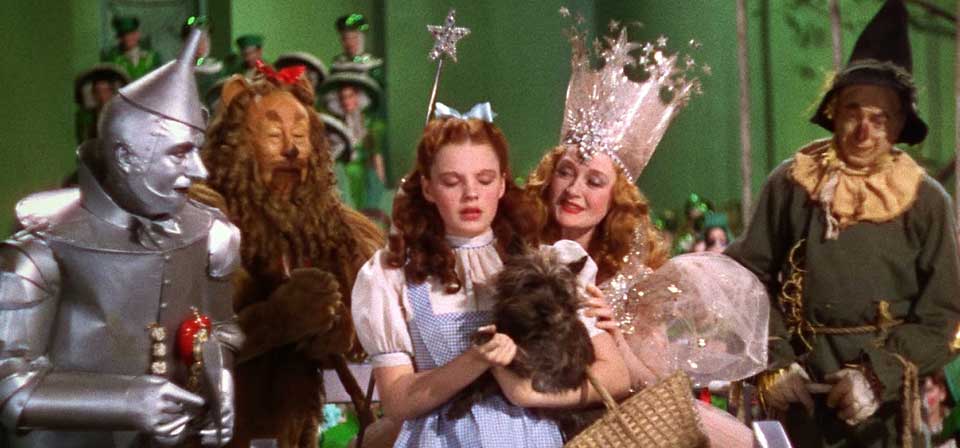
The Wizard of Oz (1939)
The Wizard of Oz is one of a very few shared experiences that unite Americans as a culture, transcending barriers of age, locale, politics, religion, and so on. We all see it when we are young, and it leaves an indelible mark on our imaginations. We can hardly imagine not knowing it. It ranks among our earliest and most defining experiences of wonder and of fear, of fairy-tale joys and terrors, of the lure of the exotic and the comfort of home.
Star Wars: Episode V – The Empire Strikes Back (1980)
(Review by Jimmy Akin) In the process of adding new depth to familiar subjects, the film often takes unexpected turns. One of the subtlest of these — so subtle that it tends not to be noticed by the audience — involves the mythic dimensions of Luke’s transformation from backwater farmboy to mystical adept.
Star Wars: Episode VI – Return of the Jedi (1983)
(Review by Jimmy Akin) In the end, Star Wars reveals itself to be not just the most ambitious science-fiction epic brought to the big screen but a story expressing the importance of family and love, the danger of moral corruption, and the possibility moral redemption.
Recent
- Benoit Blanc goes to church: Mysteries and faith in Wake Up Dead Man
- Are there too many Jesus movies?
- Antidote to the digital revolution: Carlo Acutis: Roadmap to Reality
- “Not I, But God”: Interview with Carlo Acutis: Roadmap to Reality director Tim Moriarty
- Gunn’s Superman is silly and sincere, and that’s good. It could be smarter.
Home Video
Copyright © 2000– Steven D. Greydanus. All rights reserved.